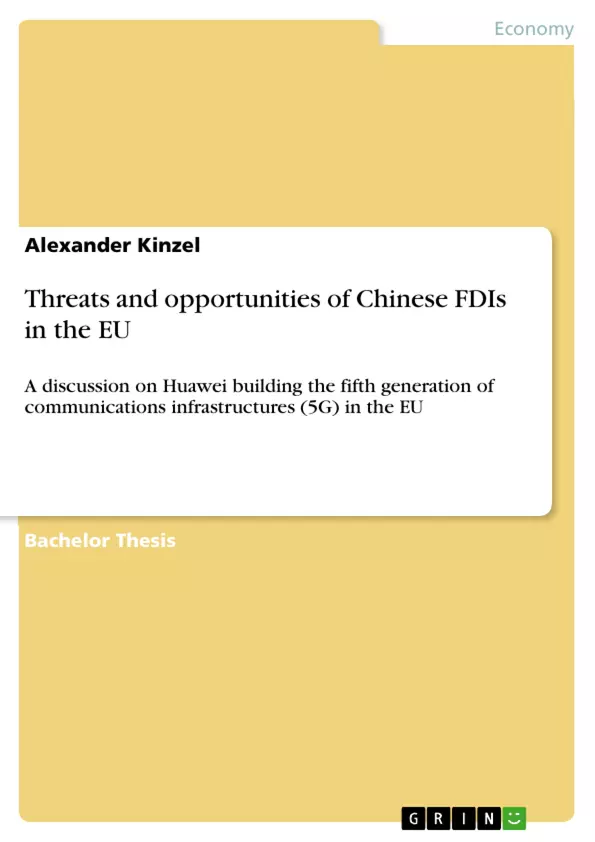Whilst taking the current trends of Chinese Foreign Direct Investments (FDI) into account, this paper plans on discussing the threats and opportunities on Chinese FDIs in the race to construct the 5G infrastructure network in Europe.
In today’s international markets, border-crossing FDIs flowing into the European Union (EU) from non-EU member states are bowing to the pressure of the uncertain economic situation. In 2017, FDI inflow to the EU from non-EU member states have declined rapidly by circa 89.2%1. China, surprisingly, only contributed to around 6.19% of the inflow of FDI from non-EU member states. According to data from a report “Chinese FDI in Europe: 2018 Trends and Impact of New Screening Policies” by Rhodium Group and the Mercator Institute for China Studies (MERICS), this stagnation is also mirrored in the flow of FDI from China to the EU, which fell from EUR 29.1 billion in 2017 to EUR 17.3 billion in 2018, which corresponds to a 40% decrease in FDI inflow to the EU2.
The economic trade between the EU and China has decreased around 40% from 2017 to 2018 . In spite of this recent stagnation, we have observed an increase of Chinese FDI to the EU from 2.1 EUR billion in 2010 to 37.2 EUR billion in 2016, with the only stagnation in this time frame (2019 to 2016) occurring from 2012 to 20133. The changing course of the total value of Chinese FDI to the European Union discussed in the sentences above are largely due to fluctuations in the value of M&A transactions, whereas the value of the Greenfield investments remains largely stable from 2010 to 2018. Hence the more volatile course of the values of M&A transactions, the ratio of Greenfield investments to M&A transactions also act accordingly.
In spite of the decrease in Chinese FDI in the EU in recent years, as seen in Figure 1, there have been a more equal and diverse investment in a broader number of sectors in the European Union, instead of proportionately large FDIs in a few sectors as seen through years 2015 to 2017 in Figure 1. This recent decrease in Chinese FDI abroad which includes a 20% decrease in Chinese mergers and acquisitions (M&A) in the first six months of 2017, is likely to be as either direct or indirect effect of the Chinese regulatory tightening on Chinese FDI .
Inhaltsverzeichnis (Table of Contents)
- INTRODUCTION
- CURRENT SITUATION OF CHINESE-EU TRADE AND CHINESE FDI COMING TO THE EU
- HUAWEI OVERVIEW
- WHAT IS THE FIFTH GENERATION 5G INFRASTRUCTURE AND HOW DOES IT DIFFER FROM PREVIOUS GENERATIONS OF TELECOMMUNICATION INFRASTRUCTURES?
- EU PERSPECTIVE
- THREATS FROM HUAWEI CONDUCTING FDIS IN THE EUROPEAN UNION
- SECURITY CONCERN
- DETRIMENTAL IMPACT FOR EU COMPANIES IF CHEAP CHINESE HUAWEI COMES WITH COMPETITION
- EU'S TRADE DEFICIT WITH CHINA CREATES A STRONG DEPENDENCY ON CHINA FOR TRADE
- OPPORTUNITIES FROM HUAWEI CONDUCTING FDIS IN THE EUROPEAN UNION
- WITH HUAWEI, THE 5G INFRASTRUCTURE COMES SOONER, CHEAPER AND BOOSTS EU COMPETITIVENESS
- JOB CREATION IN THE EU
- CONTRIBUTING TO ECONOMIC GROWTH, LABOUR MARKET RECEIVES MORE KNOW-HOW THROUGH CHN INVESTMENT
- THREATS FROM HUAWEI CONDUCTING FDIS IN THE EUROPEAN UNION
- CHINESE PERSPECTIVE
- THREATS FROM HUAWEI CONDUCTING FDIS IN THE EUROPEAN UNION
- INCREASING CAPITAL FLIGHT AND THE INCREASING REGULATION THEREOF
- THE UNCERTAINTY OF EU MEMBER STATES' POLICIES CONCERNING CHINESE FDI IN 5G TELECOMUNICATION INFRASTRUCTURE AND LACK OF COMMON SECURITY FRAMEWORK CREATING ADDITIONAL COSTS
- LIABILITY OF FOREIGNNESS
- OPPORTUNITIES FROM HUAWEI CONDUCTING FDIS IN THE EUROPEAN UNION
- CHINA'S POTENTIAL TO ATTAIN A STRONGER COMPETITIVE ADVANTAGE THROUGH R&D
- "SCIENCE DIPLOMACY" AS AN OPPORTUNITY FOR MORE TRADE WITH THE EU AND FOR MORE DECONSTRUCTION OF THE LIABILITIES OF FOREIGNNESS
- THREATS FROM HUAWEI CONDUCTING FDIS IN THE EUROPEAN UNION
Zielsetzung und Themenschwerpunkte (Objectives and Key Themes)
This bachelor's thesis presents a comprehensive analysis of the threats and opportunities associated with Chinese investments in the European Union, specifically focusing on the political and macroeconomic implications. The analysis utilizes the case study of Huawei's potential investment in the Fifth Generation (5G) telecommunication infrastructure to understand the nuanced challenges and benefits of Chinese FDIs in strategic sectors like telecommunications within the European Union.
- The impact of Chinese Foreign Direct Investments (FDIs) on the European Union's economy and security.
- The potential threats posed by Chinese companies like Huawei participating in the construction of 5G infrastructure in the EU.
- The opportunities presented by Chinese investments in 5G infrastructure for the European Union, particularly in terms of technological advancement and economic growth.
- The implications of China's role in shaping the 5G landscape for the European Union.
- The role of international cooperation and policy coordination in mitigating potential risks and maximizing opportunities associated with Chinese investments in the EU.
Zusammenfassung der Kapitel (Chapter Summaries)
The thesis begins with an introduction, providing context for the analysis and outlining the research question. Chapter 2 presents a detailed overview of the current state of Chinese-EU trade relations and Chinese FDI flows into the EU. Chapter 3 provides a background on Huawei, exploring its business model, technological capabilities, and global presence. Chapter 4 discusses the significance of 5G technology and its distinction from previous generations of telecommunication infrastructures. Chapter 5 presents the EU's perspective on the threats and opportunities associated with Chinese FDIs in the 5G infrastructure. Chapter 6 explores the Chinese perspective, highlighting the potential benefits and challenges of Huawei's involvement in the EU's 5G infrastructure development.
Schlüsselwörter (Keywords)
The primary keywords and focus topics of the thesis include: Chinese Foreign Direct Investments (FDIs), European Union (EU), Huawei, 5G telecommunication infrastructure, security concerns, economic opportunities, trade relations, political economy, macroeconomic development, liability of foreignness, science diplomacy.
- Quote paper
- Alexander Kinzel (Author), 2019, Threats and opportunities of Chinese FDIs in the EU, Munich, GRIN Verlag, https://www.grin.com/document/502812



